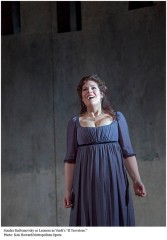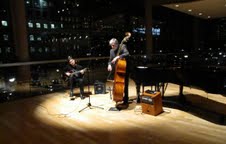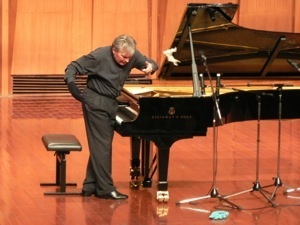Angela Hewitt Then and Now
I heard pianist Angela Hewitt on Friday night, when she gave a recital at Roy Thomson Hall: Bach’s Italian Concerto, Beethoven’s Sonata Op. 10 No. 3 and Brahms’ Sonata No. 3. As the programme notes explained, this repertoire was chosen for a specific reason. These works were among the pieces she played on the same stage 25 years ago – in her successful effort to win first prize in the 1985 Toronto International Bach Competition.
Tono by Red Sky
Just how would the theatrical dance company Red Sky present the music of a spectacular integrated dance theatre work, by itself? I was curious to hear for myself at The Music Gallery on January 20.
Mary Gardiner
With the passing of Mary Gardiner on January 30, Canadian music has lost a true leader. Mary’s extraordinary range of activities touched many lives and influenced many organizations.
Mary was an eloquent and persuasive advocate for Canadian music. She had a gentle manner, but she was fierce in her determination to get things done. Her tireless work with the Association of Canadian Women Composers, the Alliance for Canadian New Music Projects, and the Canadian Music Centre left an indelible mark. To honour her achievements, the CMC and the Canadian League of Composers gave her their Friends of Canadian Music Award in 2003, and the Alliance for Canadian New Music Projects established a scholarship in her name.
As a composer, pianist, conductor and teacher, Mary accomplished far more than she would ever admit to. Her own compositions have been recorded, broadcast, and performed around the world.
Mary led by example. Her kindness, generosity, elegance, marvelous sense of humour, unusual sensitivity, and reassuring confidence went far to help her accomplish so much. People listened to her.
A selection from recordings of Mary’s compositions can be heard on the Canadian Music Centre’s website: http://www.musiccentre.ca
We offer our deepest sympathies to her family.
Pamela Margles
Shining Bits and Pieces
Here's an artist, and a demo disc, worth talking about!
The intimate clarity Michelle Willis' Shining Bits and Pieces, an EP demo of original songs, captures and reveals every expressive nuance of the singer/pianists' silky voice. Twisting and turning, these songs explore the lyrics’ journey, creating musical textures that enwrap the listener. Shining does exactly that, glistening with freshness and energy.
The funky Quincy Jones-like groove of “Psychology” gives us a taste of Willis’ blues-R&B chops. She's able to make perfect sense of the quirky almost-anti-melodic semitone dissonance of “Rain,” and brings a wonderful spontaneity to “Weightless” and “Love Song.” Like other songs on this recording, “Open Hands” constantly entices and surprises with shifts of time, style, and texture. Backed by Heather Crawford (guitar), Charles James (bass), Shawn Rompre (drums), Kristjan Bergey (tenor sax) and vocalists Marla Walters, Janee Olivia and Andre Reid, Willis has a seemingly endless resource of vocal colours – breathy whisper, feline purr, bluesy growl, soulful wail – all used so naturally.
We’ll definitely be hearing more about this extremely talented singer-songwriter. In fact, you can hear her at the Rex this month, on February 9, 16, and 23, at 6:30 pm.
Frankenstein
On January 20, TrypTych gave the world premiere of Frankenstein by Andrew Ager, composer-in-residence at Toronto’s St. James Cathedral. TrypTych has previously presented individual scenes from the opera, but on the 20th and 22nd (when I attended) we were supposedly seeing the completed work. I hope this is not true. The 70-minute minute piece has so much potential and Ager’s music so evocative that it really should be at least half again as long.
William Whitla’s five-scene libretto adheres closely to Mary Shelly’s original novel and thankfully dispenses with all of Hollywood accretions of schlock that have so distorted the tale. The opera, like the novel, is not a horror story but a philosophical meditation on the relation of creator and creation. Again and again there were moments when I wished the librettists would pause the action and allow characters to reflect more fully on their situation. Victor Frankenstein and the Monster both flee the laboratory after the Monster’s animation, but we really need to know more how each feels about that experience. The Monster peers in at the family he has secretly been helping. This would be a perfect time to have him reflect on the peace he sees inside and the alienation he feels outside. The use of Milton’s Paradise Lost as a parallel text in the De Lacey family scene could be much more extended.
There are dramaturgical problems. Frankenstein and the Monster should not really have their central encounter while a boy’s body lies ignores on the ground. The deaths of Frankenstein’s wife and brother really don’t need to be shown in the final scene since they tend to pitch the tone into melodrama, which it had till then avoided.
Despite this, the opera is gripping from start to finish. I wanted more because what there was, was so enjoyable. The librettists have boiled the story down to its bare essentials which are even more timely now when mankind really can artificially create life. Ager himself played the score on a grand piano, where it sounded like a gorgeous post-impressionist tone poem, lush yet propulsive, where constantly shifting tonalities reflected the morally ambiguous world of the story.
Of the cast of eight, Stephen King was the clear standout with a bass-baritone voice of great beauty and power, whose fine singing and acting painted the Monster in the most sympathetic light. As Victor Frankenstein, tenor Lenard Whiting had some difficulty with the highest lying notes, but successfully replaced the caricature of the “mad scientist” with a more psychological portrait of obsession. Baritone Michael York used his well rounded tone to characterize and differentiate the anger of Victor’s father from the serenity of Old Mr. De Lacey. Michael Taylor and Melanie Conly beautifully sang a duet celebrating the married bliss of Felix and Agatha De Lacey. Eleven-year-old Charles Waddell clearly showed abundant talent as Victor’s nephew. Though Graham Robinson and Dawn Bailey were given little to do as Victor’s best friend and his fiancée, they did it well.
Director and designer Edward Franko worked wonders in staging such a work on a microscopic budget. The performance was enthusiastically received – but I still feel an expanded version would have a greater chance of attracting the interest of other companies.
Christopher Hoile
John Norris
An important voice in jazz was stilled when John Norris died on January 31.
Born in Surrey, England, in 1934 he emigrated to Canada in the mid-50s, first to Montreal where he operated the Montreal Traditional Jazz Society from 1956 to 1957 before moving to Toronto where soon became involved with the Traditional Jazz Club of Toronto. In 1958 Coda magazine was established with co-founder, Bill Smith, followed ten years later by Sackville Records. Both became recognized as models of integrity and honesty.
He was an authority on jazz and a respected critic, writer, broadcaster and promoter who never once compromised his opinions and values. As well as writing regularly for Coda, he contributed over the years to many of the other leading music publications – Jazz Journal, Melody Maker, Downbeat and International Musician – wrote a jazz history series for radio and for more than twenty years taught a jazz history course at the University of Toronto.
An unassuming man, but unshakable in his conviction, not gregarious but comfortable among his friends, he had the respect and admiration of all the musicians who recorded for the Sackville label: artists ranging in styles from Willie "The Lion" Smith to Anthony Braxton. The label, from its humble beginnings, established itself as perhaps the world's leading independent record company.
Jazz has lost a great friend, and a true supporter of the music and the artists who perform it.
Jim Galloway
COC Announces New Season
On January 20, COC General Director Alexander Neef announced the company’s 61st season. Of special significance is that this is the first season planned entirely by Neef. It was clear that Neef looked to see what works the COC had been neglecting because five operas are works the COC has not staged for at least twelve years and two are COC premieres.
 The season opens on October 2 with a new production of Verdi’s Aida directed by Tim Albery and starring Sondra Radvanovsky in her company debut. Next is a new production of Britten’s Death in Venice conducted by Steuart Bedford, who conducted the opera’s world premiere in 1973. The winter season begins with a new production of Mozart’s Magic Flute directed by Diane Paulus and starring Michael Schade and Isabel Bayrakdarian. This is paired with the COC premiere of John Adams’s modern classic Nixon in China with Tracy Dahl as Madame Mao. The spring season brings a new production of Rossini’s La Cenerentola with Brett Polegato as Dandini; Ariadne auf Naxos with Adrianne Pieczonka and Richard Margison; and finally, and surprisingly, the COC premiere of Gluck’s Orfeo ed Euridice directed by Robert Carsen with Lawrence Zazzo and Isabel Bayrakdarian.
The season opens on October 2 with a new production of Verdi’s Aida directed by Tim Albery and starring Sondra Radvanovsky in her company debut. Next is a new production of Britten’s Death in Venice conducted by Steuart Bedford, who conducted the opera’s world premiere in 1973. The winter season begins with a new production of Mozart’s Magic Flute directed by Diane Paulus and starring Michael Schade and Isabel Bayrakdarian. This is paired with the COC premiere of John Adams’s modern classic Nixon in China with Tracy Dahl as Madame Mao. The spring season brings a new production of Rossini’s La Cenerentola with Brett Polegato as Dandini; Ariadne auf Naxos with Adrianne Pieczonka and Richard Margison; and finally, and surprisingly, the COC premiere of Gluck’s Orfeo ed Euridice directed by Robert Carsen with Lawrence Zazzo and Isabel Bayrakdarian.
Again the COC Ensemble Studio is allowed to take over one performance of The Magic Flute, rather than being given its own production. This is unfortunate because the Ensemble productions were a way for the COC to stage a wide range of chamber operas, from baroque to contemporary, that helped to broaden our perceptions of what opera is.
Christopher Hoile
Polish Perspectives Wraps Up
Pianist-composer Zygmunt Krauze, the subject of my last blog, presented a public lecture on his and his fellow Pole’s music by at the Faculty of Music, University of Toronto. For over 40 years Krauze has enjoyed a successful career not only as a musician but also as a key administrator in both the Polish and international new music scenes. His insights therefore reflect a refreshingly positive central European point of view on new music. It certainly puts into relief what many insiders believe is the veritable outsider status Canadian new music and musicians generally enjoy today.
The COC Reaches Out
 The word “privileged” kept going through my head as I stood in the Richard Bradshaw Amphitheatre in Toronto listening to a jazz concert last Wednesday evening. The word can have negative connotations, since opera and other “high brow” artistic endeavours are often perceived as being accessible only to the educated and wealthy. Certainly the Canadian Opera Company (COC) and the Four Seasons Centre, where the Richard Bradshaw Amphitheatre is located, would be familiar with such accusations. But as I enjoyed a free concert, being played by two of the finest jazz musicians in this country, in one of the most breathtaking performance spaces I've ever been in, “privilege” took on a whole new meaning.
The word “privileged” kept going through my head as I stood in the Richard Bradshaw Amphitheatre in Toronto listening to a jazz concert last Wednesday evening. The word can have negative connotations, since opera and other “high brow” artistic endeavours are often perceived as being accessible only to the educated and wealthy. Certainly the Canadian Opera Company (COC) and the Four Seasons Centre, where the Richard Bradshaw Amphitheatre is located, would be familiar with such accusations. But as I enjoyed a free concert, being played by two of the finest jazz musicians in this country, in one of the most breathtaking performance spaces I've ever been in, “privilege” took on a whole new meaning.
Polish Perspectives II
 “What makes a complete musician?” That was the thought-provoking question Robert Aitken, New Music Concerts’ artistic director and host of Monday night’s concert at Gallery 345 asked the evening’s featured soloist, Polish pianist-composer Zygmunt Krauze.
“What makes a complete musician?” That was the thought-provoking question Robert Aitken, New Music Concerts’ artistic director and host of Monday night’s concert at Gallery 345 asked the evening’s featured soloist, Polish pianist-composer Zygmunt Krauze.
Aitken answered his own question first. He revealed that when wearing his composer’s hat, his mission draws him deep inside in reflection and soul-searching self-examination. On the other hand, as a performer, he finds he must direct his energy outward to be able to engage musically with his colleagues and audience. The dichotomy is enough to tear a sensitive artist apart.
On the contrary, Zygmunt Krauze pointed out that the classical triumvirate skill set of performing musician-composer-teacher has worked for him very well. Each aspect had in his case reinforced the other to help him build a 50-year career as a "complete musician." In fact, he added, that three-cornered job-description has been the gold standard of almost all of the notable composers Europe has produced.
With philosophical matters out of the way, Zygmunt Krauze’s piano recital followed on the heels of Sunday’s concert. That concert featured small and large ensemble performances of the music of a cadre of contemporary Polish composers, at the CBC’s Glenn Gould Studio. The present recital, however, was dedicated to the piano music of just three Polish composers, active over three centuries: Chopin, Lutoslawski and Krauze himself.
Krauze began with a muscular performance of Fryderyk Chopin’s Mazurka, a-moll no. 4 op. 67 (1846), which filled the intimate gallery space with the lush sonorities of the freshly tuned grand piano. Krauze’s interpretations are by no means standard, however. He regularly employs unorthodox dynamics, articulation and tempi – and even more unusual is his practice of moving off in an unexpected improvisational tangent. He did just that in this 19th-century opus, as well as in an early work by his colleague and friend, the late Witold Lutoslawski.
Zygmunt Krauze’s own music for piano ranged from the early pseudo-folk – Six Folk Melodies (1958) – to the physical theatre of Gloves Music (1972), and to his mature multi-layered musical voice revealed in Refrain (1993).
For me, his Stone Music (1972) proved the most magical music journey of the evening. Performed directly on the strings of the piano and eschewing the keyboard, Krauze employed just three stones and two small metal rods to evoke slowly shifting and eerie sound clouds. Most remarkably, at times the sound which filled the space evoked quite accurately a string section and at other times a wind choir. It was soft and quite exquisite.
More Articles ...
Podcasts
The WholeNote Podcasts
 Welcome to the Conversations <at> The WholeNote podcast page. Below you will find our podcast episodes for your listening pleasure.
Welcome to the Conversations <at> The WholeNote podcast page. Below you will find our podcast episodes for your listening pleasure.
To listen, you have a few options:
- You can listen via this website you can scroll down and find the episode you'd like and click play there.
- Or you can download and save the podcasts on your phone, tablet or computer - and then you can listen to it anytime (even without an internet connection) by downloading from the episode articles below.
- Or you can subscribe to this podcast on your favourite podcast service including iTunes, Google Play, Stitcher, BluBrry, PocketCasts and more. Just open your podcast app and search for Conversations at The WholeNote and hit 'subscribe'.
If you are unable to find us on the podcast app that you use, please let us know and we'll do our best to try and make it available to you.
Scroll down to select individual episodes to enjoy.



